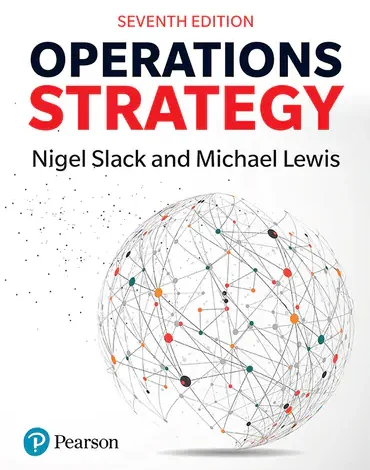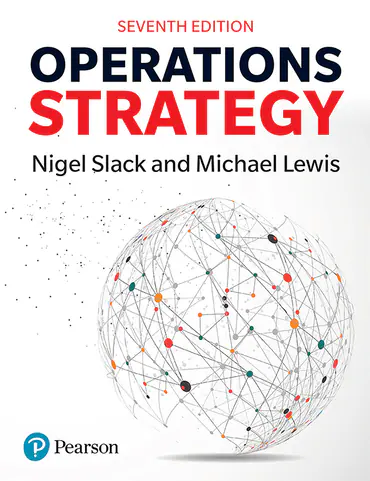دانلود کتاب Operations Strategy 7th edition

خرید ایبوک Operations Strategy, 7th edition
برای دانلود ایبوک Operations Strategy, 7th edition و خرید کتاب استراتژی عملیات، ویرایش هفتم، بر روی کلید خرید در انتهای صفحه کلیک کنید. پس از اتصال به درگاه پرداخت هزینه و تکمیل مراحل خرید، لینک دانلود کتاب ایمیل می شود.این ایبوک در فرمت EPub به همراه PDF تبدیلی و به زبان انگلیسی ارسال می شود.نسخه الکترونیکی کتاب قابلیت کپی برداری copy و Paste دارد. منابع استادی شامل پاورپورینت و راهنمای مربی این ایبوک در پست دیگری قابل خرید است.
در صورتی که نیاز به پی دی اف هر کتابی از انتشارات pearsonدارید با گیگاپیپر مکاتبه کنید.
خرید کتاب Operations Strategy

Operations Strategy, 7th edition
Published by Pearson (October 20, 2023) © 2024
Nigel Slack Warwick Business School, Warwick UniversityMike Lewis Bath University
ISBN-13: 9781292459288
Operations Strategy
Published 2023
Send email to download :![]()
Price : 25$
https://www.pearson.com/en-gb/subject-catalog/p/operations-strategy/P200000010645/9781292459288
دانلود رایگان کتاب Operations Strategy 7th Edition
“Sets the standard for excellence in the field and distinguishes itself as a truly vital and comprehensive book within its domain. The book is enriched by numerous real-world and up-to-date examples, along with insightful case studies, ensuring that the readers gain a holistic understanding of the subject.” Dr Arijit Bhattacharya, Associate Professor in Operations & Supply Chain Management, Norwich Business School, UEA The go-to resource on operations strategy, exploring key activities, processes and decisions adopted by a wide range of businesses Operations Strategy, 7th edition encourages a thorough understanding of the topic, building on concepts from strategic and operations management to marketing and HR management. The way an organisation manages their operations strategically can have a huge impact on its prospects – whether large or small, service or manufacturing, for-profit or not-for-profit, international or local. Operations strategy is fundamental to the success of any organisation and a major source of competitive advantage. The text encourages you to explore the key strategic decisions adopted by a wide range of organisations in different sectors, and is ideal for MBA students, upper-level undergraduates, postgraduates and executives. “Slack and Lewis have approached the ethical, societal, and environmental issues affecting business operations strategy in a post-pandemic world, with a blend of new chapters and contemporary case studies based on both external and internal contexts – an essential item for any serious Operations Strategy resource list.” Jamie Rundle, Senior Lecturer in Management, Nottingham Business School, UK New to this edition: More on responsible and sustainable operations brings the book up to date with recent developments, showing how operations impact social, ethical, and environmental issues. Increased emphasis on risk in operations strategy and the importance of external and internal context. Updated with several new examples throughout – now including an even wider range of different types of organisation. Four new case studies (bringing the total to 18) explore real-life practical applications to use in class or individually to ground theoretical concepts: House Partnerships at Concept Design Services, IKEA Looks to the Future, Kaston-Trenton Services, and computer game development at Widescale Studio. “To me, the textbook of Slack and Lewis is the best in the field of Operations Strategy.” Jan de Vries, Professor of Operations Management, University of Groningen, The Netherlands
دانلود ایبوک استراتژی عملیات ویرایش هفتم
معیارهای برتری در این زمینه را تعیین می کند و خود را به عنوان یک کتاب واقعاً حیاتی و جامع در حوزه خود متمایز می کند. این کتاب با نمونه های واقعی و به روز متعدد، همراه با مطالعات موردی روشنگرانه غنی شده است، و تضمین می کند که خوانندگان درک جامعی از موضوع به دست آورید.” دکتر آریجیت باتاچاریا، دانشیار در مدیریت عملیات و زنجیره تامین، مدرسه بازرگانی نورویچ، UEA منبع اصلی استراتژی عملیات، کاوش در فعالیتهای کلیدی، فرآیندها و تصمیمات اتخاذ شده توسط طیف وسیعی از کسبوکارها، استراتژی عملیات، ویرایش هفتم، درک کامل را تشویق میکند. از موضوع، بر اساس مفاهیمی از مدیریت استراتژیک و عملیات تا بازاریابی و مدیریت منابع انسانی. روشی که یک سازمان به صورت استراتژیک عملیات خود را مدیریت می کند می تواند تأثیر زیادی بر چشم انداز آن داشته باشد – چه بزرگ یا کوچک، خدماتی یا تولیدی، انتفاعی یا غیرانتفاعی، بین المللی یا محلی. استراتژی عملیات برای موفقیت هر سازمانی اساسی است و منبع اصلی مزیت رقابتی است. این متن شما را تشویق میکند تا تصمیمات استراتژیک کلیدی اتخاذ شده توسط طیف گستردهای از سازمانها در بخشهای مختلف را بررسی کنید، و برای دانشجویان MBA، دانشآموختگان سطح بالا، فارغالتحصیلان و مدیران اجرایی ایدهآل است. Slack و Lewis با ترکیبی از فصول جدید و مطالعات موردی معاصر بر اساس زمینههای خارجی و داخلی به مسائل اخلاقی، اجتماعی و زیستمحیطی مؤثر بر استراتژی عملیات کسبوکار در دنیای پسا همهگیر نزدیک شدهاند – یک مورد ضروری برای هر عملیات جدی. فهرست منابع استراتژی.” جیمی راندل، مدرس ارشد مدیریت، مدرسه بازرگانی ناتینگهام، انگلستان تازه وارد این نسخه: اطلاعات بیشتر در مورد عملیات مسئولانه و پایدار، این کتاب را با پیشرفتهای اخیر بهروز میکند و نشان میدهد که چگونه عملیاتها بر مسائل اجتماعی، اخلاقی و زیستمحیطی تأثیر میگذارند. تاکید بیشتر بر ریسک در استراتژی عملیات و اهمیت زمینه خارجی و داخلی. با چندین نمونه جدید در سراسر به روز شد – اکنون شامل طیف گسترده تری از انواع مختلف سازمان است. چهار مطالعه موردی جدید (که مجموع آنها را به 18 می رساند) کاربردهای عملی در زندگی واقعی را برای استفاده در کلاس یا به صورت انفرادی در مفاهیم نظری بررسی می کند: مشارکت های خانه در خدمات طراحی مفهومی، IKEA نگاه به آینده، خدمات Kaston-Trenton، و توسعه بازی های رایانه ای. در استودیو Widescale. برای من کتاب درسی اسلک و لوئیس بهترین کتاب در زمینه استراتژی عملیات است. Jan de Vries، استاد مدیریت عملیات، دانشگاه گرونینگن، هلند
فهرست مطالب ایبوک Operations Strategy 7th Edition
- Cover Page
- Title
- Copyright
- Brief contents
- Contents
- List of figures, tables and exhibits from case studies
- Preface
- Authors’ acknowledgements
- Publisher’s acknowledgements
- Chapter 1 What is operations strategy?
- Introduction
- 1.1 Why is operations excellence fundamental to strategic success?
- 1.2 What is operations strategy and how is it different from operations management?
- 1.3 How should operations strategy reflect overall strategy (top-down)?
- 1.4 How do the requirements of the market influence operations strategy (outside-in)?
- 1.5 How can operations strategy learn from operational experience (bottom-up)?
- 1.6 How can the intrinsic capabilities of an operation’s resources influence operations strategy (inside-out)?
- Summary answers to key questions
- Further reading
- Notes on the chapter
- Chapter 2 The context, content and process of operations strategy
- Introduction
- 2.1 What is the difference between the context, content and the process of operations strategy?
- 2.2 What is the context of operations strategy?
- 2.3 What is the content of operations strategy?
- 2.4 What is the process of operations strategy?
- Summary answers to key questions
- Further reading
- Notes on the chapter
- Chapter 3 Operations performance
- Introduction
- 3.1 What is meant by operations performance?
- 3.2 How is operations performance judged at a societal level?
- 3.3 How is operations performance judged at a strategic level?
- 3.4 How is operations performance judged at an operational level?
- 3.5 Does the relative importance of performance objectives vary over time?
- 3.6 Do operations performance objectives trade-off against each other?
- 3.7 What are the advantages and disadvantages of focused operations?
- Summary answers to key questions
- Further reading
- Notes on the chapter
- Chapter 4 Responsible operations strategy
- Introduction
- 4.1 What is responsible operations strategy?
- 4.2 How does the environmental dimension of responsibility affect operations strategy?
- 4.3 How does the social dimension of responsibility affect operations strategy?
- 4.4 How does the economic dimension of responsibility affect operations strategy?
- 4.5 How does the stakeholder dimension of responsibility affect operations strategy?
- 4.6 How does the voluntariness dimension of responsibility affect operations strategy?
- Summary answers to key questions
- Further reading
- Notes on the chapter
- Chapter 5 Capacity strategy
- Introduction
- 5.1 What is capacity strategy?
- 5.2 How much capacity should an operation have?
- 5.3 How many separate sites should an operation have?
- 5.4 What issues are important when changing capacity levels?
- 5.5 What tasks should be allocated to sites?
- 5.6 Where should capacity be located?
- Summary answers to key questions
- Further reading
- Notes on the chapter
- Chapter 6 Purchasing and supply strategy
- Introduction
- 6.1 What is purchasing and supply strategy?
- 6.2 What should we do and what should we buy?
- 6.3 How we buy: what is the role of contracts and/or relationships?
- 6.4 How do we manage supply dynamics?
- 6.5 How do we manage supply networks over time?
- 6.6 How do we manage supply chain risks?
- Summary answers to key questions
- Further reading
- Notes on the chapter
- Chapter 7 Process technology strategy
- Introduction
- 7.1 What is process technology strategy and why is it becoming more important?
- 7.2 How can process technology be characterised?
- 7.3 How do market volume and variety influence process technology?
- 7.4 How can process technology be evaluated strategically?
- Summary answers to key questions
- Further reading
- Notes on the chapter
- Chapter 8 Improvement strategy
- Introduction
- 8.1 What are the different approaches to improvement?
- 8.2 How do the needs of the market direct the ongoing development of operations processes?
- 8.3 How can the ongoing management and control of operations be harnessed to develop their capabilities?
- 8.4 What can operations do to deploy their capabilities into the market?
- Summary answers to key questions
- Further reading
- Notes on the chapter
- Chapter 9 Product and service development strategy
- Introduction
- 9.1 What is the relationship between innovation, design and creativity?
- 9.2 Why is the way in which companies develop their products and services so important?
- 9.3 What process do companies use to develop products and services?
- 9.4 How should the effectiveness of the product and service development process be judged in terms of fulfilling market requirements?
- 9.5 What operations resource-based decisions define a company’s product and service development strategy?
- Summary answers to key questions
- Further reading
- Notes on the chapter
- Chapter 10 The process of operations strategy – formulation and implementation
- Introduction
- 10.1 What is the ‘formulation’ of operations strategy?
- 10.2 What is involved in maintaining alignment over time?
- 10.3 What analysis is needed for formulation?
- 10.4 What is operations strategy implementation?
- 10.5 Who can be responsible for implementation?
- Summary answers to key questions
- Further reading
- Notes on the chapter
- Chapter 11 The process of operations strategy – monitoring and control
- Introduction
- 11.1 What are the differences between operational and strategic monitoring and control?
- 11.2 How is progress towards strategic objectives tracked?
- 11.3 How can monitoring and control attempt to control risks?
- 11.4 How does learning contribute to strategic control?
- Summary answers to key questions
- Further reading
- Notes on the chapter
- Topics covered in case studies
- List of case studies
- Aarens Electronic
- Aztec Component Supplies
- Clever Consulting
- Delta Synthetic Fibres (DSF)
- Design house partnerships at Concept Design Services
- Developing ‘Savory Rosti-crisps’ at Dreddo Dan’s
- Disneyland Resort Paris
- Dresding Medical
- Hagen Style
- IKEA looks to the future
- Kaston-Trenton Services (KTS)
- McDonald’s: half a century of growth
- Ontario Facilities Equity Management (OFEM)
- Slagelse Industrial Services (SIS)
- Turnround at the Preston Plant
- Widescale Studio and the Fierybryde development
- Zara’s operating model
- Zentrill
- Glossary
- Index